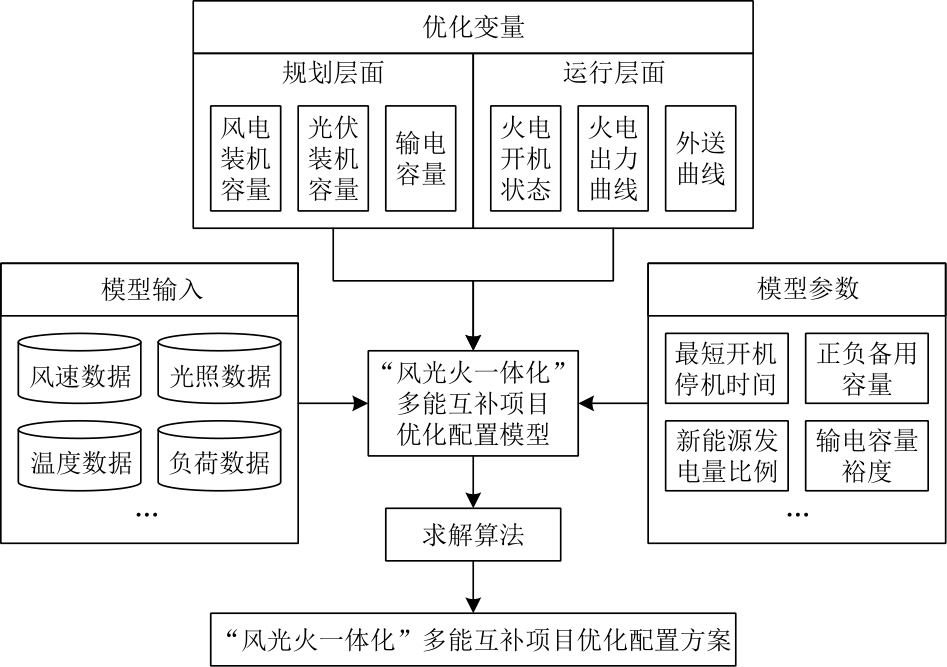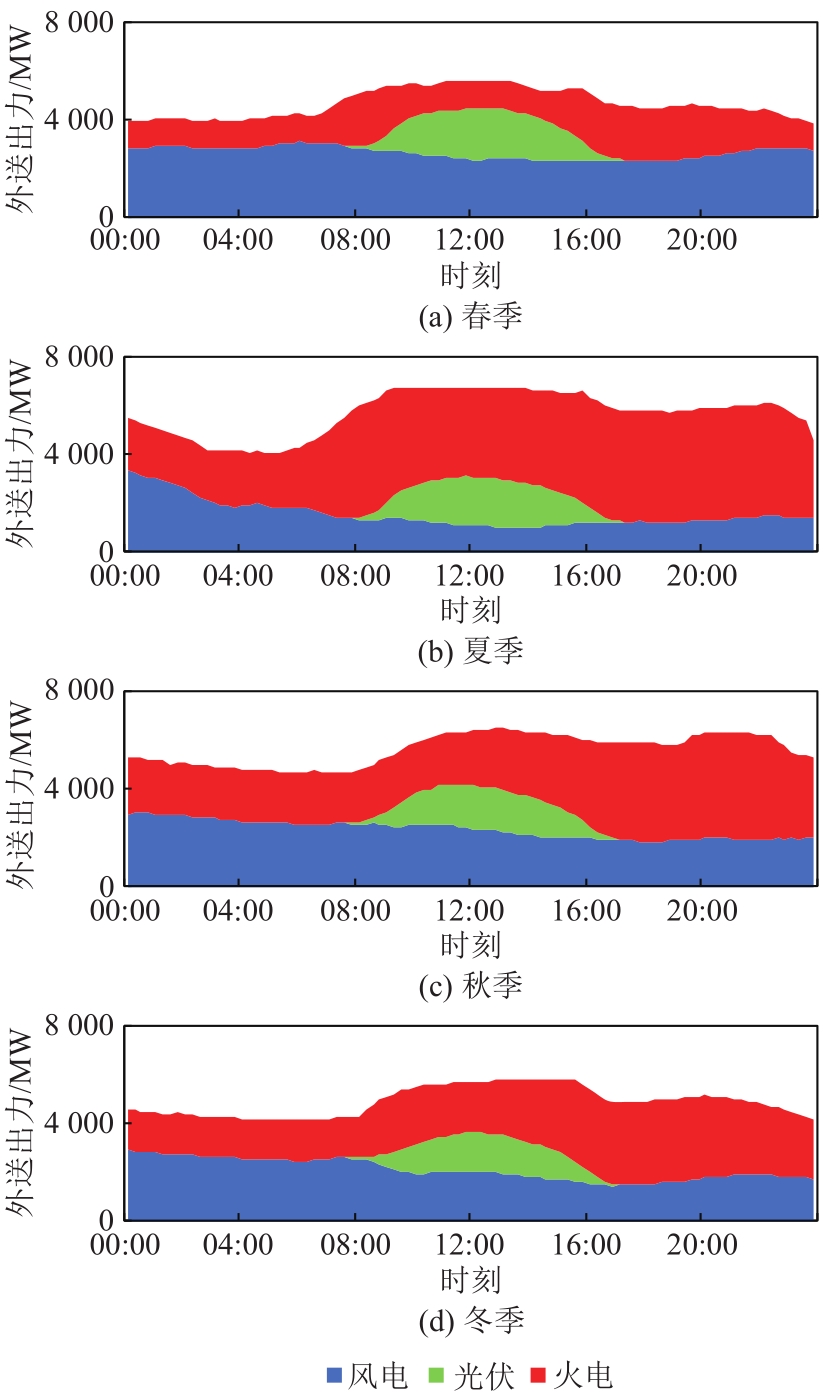

发电技术 ›› 2022, Vol. 43 ›› Issue (1): 10-18.DOI: 10.12096/j.2096-4528.pgt.21101
周保中1, 刘敦楠2, 张继广1, 李忆1, 徐尔丰2,3, 毕圣1
收稿日期:2021-08-06
出版日期:2022-02-28
发布日期:2022-03-18
作者简介:基金资助:Baozhong ZHOU1, Dunnan LIU2, Jiguang ZHANG1, Yi LI1, Erfeng XU2,3, Sheng BI1
Received:2021-08-06
Published:2022-02-28
Online:2022-03-18
Supported by:摘要:
“风光火一体化”多能互补项目能够发挥不同类型电源之间协调互济能力,是安全高效利用新能源及实现碳中和、碳达峰目标的实施路径之一。如何合理配比火电、风电、光伏装机容量以及输电容量,保障风电、光伏全额消纳和高效利用,是“风光火一体化”多能互补项目的核心问题。在分析不同类型电源出力特性和多能互补特性基础上,以总成本最小化,外送曲线和受端地区负荷曲线匹配程度最大化为目标,构建“风光火一体化”多能互补项目优化配置模型,在规划层面优化风电、光伏装机容量以及输电容量,在运行层面优化火电运行方式、出力曲线以及外送曲线。根据案例分析可知,优化配置模型能够优化确定风电、光伏装机容量以及输电容量,使不同类型电源在月、日等时间尺度上协调互济,外送曲线对受端地区电网更加友好,实现横向多能互补、纵向源荷协调。
中图分类号:
周保中, 刘敦楠, 张继广, 李忆, 徐尔丰, 毕圣. “风光火一体化”多能互补项目优化配置研究[J]. 发电技术, 2022, 43(1): 10-18.
Baozhong ZHOU, Dunnan LIU, Jiguang ZHANG, Yi LI, Erfeng XU, Sheng BI. Research on Optimal Allocation of Multi-Energy Complementary Project of Wind-Solar-Thermal Integration[J]. Power Generation Technology, 2022, 43(1): 10-18.

图1 “风光火一体化”多能互补项目优化配置模型整体框架图
Fig. 1 Overall framework of optimal allocation model for multi-energy complementary project of wind-solar-thermal integration
| 序号i | 电能成本/(元/MW) | 开机成本/ (106元/次) | ||
|---|---|---|---|---|
| ai /10-5 | bi | ci | ||
| 1和5 | 0.644 | 0.224 | 11.71 | 6 |
| 2和6 | 0.935 | 0.219 | 13.21 | 6 |
| 3和7 | 0.944 | 0.218 | 8.80 | 6 |
| 4和8 | 0.631 | 0.222 | 12.68 | 6 |
表1 火电电能成本和开机成本
Tab. 1 Thermal power cost and start-up cost
| 序号i | 电能成本/(元/MW) | 开机成本/ (106元/次) | ||
|---|---|---|---|---|
| ai /10-5 | bi | ci | ||
| 1和5 | 0.644 | 0.224 | 11.71 | 6 |
| 2和6 | 0.935 | 0.219 | 13.21 | 6 |
| 3和7 | 0.944 | 0.218 | 8.80 | 6 |
| 4和8 | 0.631 | 0.222 | 12.68 | 6 |
| 电源类型 | 装机容量/MW | 装机容量 占比/% | 年发电量/(亿kW·h) | 年发电量 占比/% | 年利用 时间/h |
|---|---|---|---|---|---|
| 风电 | 7 889 | 53.3 | 190 | 41.3 | 2 405 |
| 光伏 | 2 096 | 14.2 | 40 | 8.7 | 1 894 |
| 火电 | 4 800 | 32.5 | 229 | 50.0 | 4 779 |
表2 不同类型电源装机容量、年发电量和利用时间
Tab. 2 Install capacity, annual power and utilization time of different generations
| 电源类型 | 装机容量/MW | 装机容量 占比/% | 年发电量/(亿kW·h) | 年发电量 占比/% | 年利用 时间/h |
|---|---|---|---|---|---|
| 风电 | 7 889 | 53.3 | 190 | 41.3 | 2 405 |
| 光伏 | 2 096 | 14.2 | 40 | 8.7 | 1 894 |
| 火电 | 4 800 | 32.5 | 229 | 50.0 | 4 779 |
| 季节 | 外送电量/ (亿kW·h) | 风电电量占比/% | 光伏电量占比/% | 火电电量占比/% | 火电运行方式 |
|---|---|---|---|---|---|
| 春季 | 104 | 56.7 | 10.7 | 32.6 | 开4停4 |
| 夏季 | 126 | 27.2 | 8.6 | 64.2 | 开8停0 |
| 秋季 | 123 | 41.5 | 7.6 | 50.9 | 开8停0 |
| 冬季 | 106 | 43.1 | 8.0 | 49.0 | 开6停2 |
表3 不同季节外送电量及其占比和火电运行方式
Tab. 3 Sending power and its proportion and operation mode of thermal power
| 季节 | 外送电量/ (亿kW·h) | 风电电量占比/% | 光伏电量占比/% | 火电电量占比/% | 火电运行方式 |
|---|---|---|---|---|---|
| 春季 | 104 | 56.7 | 10.7 | 32.6 | 开4停4 |
| 夏季 | 126 | 27.2 | 8.6 | 64.2 | 开8停0 |
| 秋季 | 123 | 41.5 | 7.6 | 50.9 | 开8停0 |
| 冬季 | 106 | 43.1 | 8.0 | 49.0 | 开6停2 |

图3 四季典型日“风光火一体化”多能互补项目出力曲线
Fig. 3 Output curves of multi-energy complementary project of wind-solar-thermal integration on typical days of four seasons
| 场景 | 配套建设输电通道容量/MW | 年总成本/ (1012元) | 曲线匹配程度/ (109MW2) |
|---|---|---|---|
| 多能互补 | 7 894 | 2.83 | 7.73 |
| 独立运行 | 8 540 | 2.92 | 443.00 |
表4 2种场景对比分析
Tab. 4 Comparative analysis of two scenarios
| 场景 | 配套建设输电通道容量/MW | 年总成本/ (1012元) | 曲线匹配程度/ (109MW2) |
|---|---|---|---|
| 多能互补 | 7 894 | 2.83 | 7.73 |
| 独立运行 | 8 540 | 2.92 | 443.00 |
| 1 | 新华社 .习近平在气候雄心峰会上的讲话(全文)[EB/OL].(2020-12-13)[2021-08-01].. doi:10.1055/a-0975-0507 |
| Xinhua News Agency .Full text:President Xi’s speech at climate ambition summit[EB/OL].(2020-12-13)[2021-08-01].. doi:10.1055/a-0975-0507 | |
| 2 | 新华社 .习近平主持召开中央财经委员会第九次会议[EB/OL].(2021-03-15)[2021-08-01].. doi:10.37544/0173-363x-2021-03-04-15 |
| Xinhua News Agency .A meeting of the Central Committee for Financial and Economic Affairs presided over by President Xi[EB/OL].(2021-03-15)[2021-08-01].. doi:10.37544/0173-363x-2021-03-04-15 | |
| 3 | 国家发展改革委,国家能源局 .关于推进电力源网荷储一体化和多能互补发展的指导意见[EB/OL].(2021-02-25)[2021-08-01].. doi:10.1016/j.est.2021.103293 |
| NDRC,NEA .Guidance on promoting the development of Generation-grid-load-storage integration and multi-energy complementary[EB/OL].(2021-02-25)[2021-08-01]. . doi:10.1016/j.est.2021.103293 | |
| 4 | 曾鸣,杨雍琦,刘敦楠,等 .能源互联网“源-网-荷-储”协调优化运营模式及关键技术[J].电网技术,2016,40(1):114-124. doi:10.13335/j.1000-3673.pst.2016.01.016 |
| ZENG M, YANG Y Q, LIU D N,et al. “Generation-grid-load-storage” coordinative optimal operation mode of energy internet and key technologies[J].Power System Technology,2016,40(1):114-124. doi:10.13335/j.1000-3673.pst.2016.01.016 | |
| 5 | 刘敦楠,徐尔丰,许小峰 .面向园区微网的“源-网-荷-储”一体化运营模式[J].电网技术,2018,42(3):681-689. |
| LIU D N, XU E F, XU X F .“Source-network-load-storage” integrated operation model for microgrid in park[J].Power System Technology,2018,42(3):681-689. | |
| 6 | 卓振宇,张宁,谢小荣,等 .高比例可再生能源电力系统关键技术及发展挑战[J].电力系统自动化,2021,45(9):171-191. doi:10.7500/AEPS20200922001 |
| ZHUO Z Y, ZHANG N, XIE X R,et al .Key technologies and developing challenges of power system with high proportion of renewable energy[J].Automation of Electric Power Systems,2021,45(9):171-191.[7] 周兵兵,林宏宇,杨莘博,等.可再生能源多能互补系统多主体效益均衡模型[J].智慧电力,2020,48(1):74-79. doi:10.7500/AEPS20200922001 | |
| ZHOU B B, LIN H Y, YANG S B,et al .Multi-agent benefit equilibrium model for renewable energy in multi-energy complementary system[J].Smart Power,2020,48(1):74-79. doi:10.7500/AEPS20200922001 | |
| 8 | 欧阳斌,袁志昌,陆超,等 .考虑源-荷-储多能互补的冷-热-电综合能源系统优化运行研究[J].发电技术,2020,41(1):19-29. doi:10.12096/j.2096-4528.pgt.19100 |
| OYANG B, YUAN Z C, LU C,et al .Research on optimal operation of cold-thermal-electric integrated energy system considering source-load-storage multi-energy complementarity[J].Power Generation Technology,2020,41(1):19-29. doi:10.12096/j.2096-4528.pgt.19100 | |
| 9 | 华丽云,孙坚栋,王振,等 .基于多能互补的综合能源控制系统研究及应用[J].浙江电力,2020,39(7):108-114. |
| HUA L Y, SUN J D, WANG Z,et al .Research and application of an integrated energy control system based on multi-energy complement[J].Zhejiang Electric Power,2020,39(7):108-114. | |
| 10 | 李高潮,卢怀宇,孙启德,等 .基于可再生能源的冷热电联供系统集成配置与运行优化研究进展[J].电网与清洁能源,2021,37(3):106-119. doi:10.3969/j.issn.1674-3814.2021.03.015 |
| LI G C, LU H Y, SUN Q D,et al .Research progress in configuration and operation optimization of combined cooling,heating and power (CCHP) systems based on renewable energy[J].Power System and Clean Energy,2021,37(3):106-119. doi:10.3969/j.issn.1674-3814.2021.03.015 | |
| 11 | 王智冬 .特高压直流风电火电联合外送电源规模优化方法[J].电力建设,2015,36(10):60-66. doi:10.3969/j.issn.1000-7229.2015.10.009 |
| WANG Z D .Optimization method of UHVDC combined wind-thermal power transmission scale[J].Electric Power Construction,2015,36(10):60-66. doi:10.3969/j.issn.1000-7229.2015.10.009 | |
| 12 | 刘振亚,张启平,董存,等 .通过特高压直流实现大型能源基地风、光、火电力大规模高效率安全外送研究[J].中国电机工程学报,2014,34(16):2513-2522. |
| LIU Z Y, ZHANG Q P, DONG C,et al .Efficient and security transmission of wind,photovoltaic and thermal power of large-scale energy resource bases through UHVDC projects[J].Proceedings of the CSEE,2014,34(16):2513-2522. | |
| 13 | 许丹,王斌,张加力,等 .特高压直流外送风光火电力一体化调度计划模型[J].电力系统自动化,2016,40(6):25-29. doi:10.7500/AEPS20150727003 |
| XU D, WANG B, ZHANG J L,et al .Integrated transmission scheduling model for wind-photovoltaic-thermal power by ultra-high voltage direct current system[J].Automation of Electric Power Systems,2016,40(6):25-29. doi:10.7500/AEPS20150727003 | |
| 14 | 胡伟,戚宇辰,张鸿轩,等 .风光水多能源电力系统互补智能优化运行策略[J].发电技术,2020,41(1):9-18. doi:10.12096/j.2096-4528.pgt.19173 |
| HU W, QI Y C, ZHANG H X,et al .Complementary intelligent optimization operation strategy of wind-solar-hydro multi-energy power system[J].Power Generation Technology,2020,41(1):9-18. doi:10.12096/j.2096-4528.pgt.19173 | |
| 15 | 檀勤良,丁毅宏,李渝,等 .考虑经济环境平衡的风光火联合外送调度策略多目标优化[J].电力建设,2020,41(8):129-136. |
| TAN Q L, DING Y H, LI Y,et al .Multi-objective optimization of combined wind-solar-thermal power dispatching strategy considering economic-environmental equilibrium[J].Electric Power Construction,2020,41(8):129-136. | |
| 16 | 刘敦楠,徐尔丰,刘明光,等 .面向分布式电源就地消纳的园区分时电价定价方法[J].电力系统自动化,2020,44(20):19-28. doi:10.7500/AEPS20200123004 |
| LIU D N, XU E F, LIU M G,et al .TOU pricing method for park considering local consumption of distributed generator[J].Automation of Electric Power Systems,2020,44(20):19-28. doi:10.7500/AEPS20200123004 | |
| 17 | 周玮,孙辉,顾宏,等 .计及风险备用约束的含风电场电力系统动态经济调度[J].中国电机工程学报,2012,32(1):47-55. |
| ZHOU W, SUN H, GU H,et al .Dynamic economic dispatch of wind integrated power systems based on risk reserve constraints[J].Proceedings of the CSEE,2012,32(1):47-55. | |
| 18 | 姜文玲,王勃,汪宁渤,等 .多时空尺度下大型风电基地出力特性研究[J].电网技术,2017,41(2):493-499. doi:10.13335/j.1000-3673.pst.2016.0945 |
| JIANG W L, WANG B, WANG N B,et al .Research on power output characteristics of large-scale wind power base in multiple temporal and spatial scales[J].Power System Technology,2017,41(2):493-499. doi:10.13335/j.1000-3673.pst.2016.0945 | |
| 19 | 姜海洋,杜尔顺,朱桂萍,等 .面向高比例可再生能源电力系统的季节性储能综述与展望[J].电力系统自动化,2020,44(19):194-207. doi:10.7500/AEPS20200204003 |
| JIANG H Y, DU E S, ZHU G P,et al .Review and prospect of seasonal energy storage for power system with high proportion of renewable energy[J].Automation of Electric Power Systems,2020,44(19):194-207. doi:10.7500/AEPS20200204003 | |
| 20 | 张宁,周天睿,段长刚,等 .大规模风电场接入对电力系统调峰的影响[J].电网技术,2010,34(1):152-158. doi:doi:10.1097/ICO.0b013e3182000add |
| ZHANG N, ZHOU T R, DUAN C G,et al .Impact of large-scale wind farm connecting with power grid on peak load regulation demand[J].Power System Technology,2010,34(1):152-158. doi:doi:10.1097/ICO.0b013e3182000add | |
| 21 | BUTTLER A, DINKEL F, FRANZ S,et al .Variability of wind and solar power:an assessment of the current situation in the European Union based on the year 2014[J].Energy,2016,106:147-161. doi:10.1016/j.energy.2016.03.041 |
| 22 | 时珉,周海,韩雨彤,等 .一种考虑季节特性的光伏电站多模型功率预测方法[J].电网与清洁能源,2019,35(7):75-82. doi:10.3969/j.issn.1674-3814.2019.07.010 |
| SHI M, ZHOU H, HAN Y T,et al .A multi-model power forecasting approach of photovoltaic plant based on seasonal characteristics[J].Power System and Clean Energy,2019,35(7):75-82. doi:10.3969/j.issn.1674-3814.2019.07.010 | |
| 23 | 张曦,康重庆,张宁,等 .太阳能光伏发电的中长期随机特性分析[J].电力系统自动化,2014,38(6):6-13. doi:10.7500/AEPS20131009012 |
| ZHANG X, KANG C Q,Z N,et al .Analysis of mid/long term random characteristics of photovoltaic power generation[J].Automation of Electric Power Systems,2014,38(6):6-13. doi:10.7500/AEPS20131009012 | |
| 24 | HAMID S, HAMIDREZA Z, DAVID W .Impacts of largescale wind and solar power integration on California’s net electrical load[J].Renewable and Sustainable Energy Reviews,2016,58:761-774. doi:10.1016/j.rser.2015.12.287 |
| 25 | 刘吉臻 .新能源电力系统建模与控制[M].北京:科学出版社,2016. doi:10.17775/cseejpes.2016.00050 |
| LIU J Z .Modeling and controlling of alternate electrical power systems[M].Beijing:Science Press,2016. doi:10.17775/cseejpes.2016.00050 | |
| 26 | 徐浩,李华强 .火电机组灵活性改造规划及运行综合随机优化模型[J].电网技术,2020,44(12):4626-4635. doi:10.13335/j.1000-3673.pst.2019.1585 |
| XU H, LI H Q .Planning and operation stochastic optimization model of power systems considering the flexibility reformation[J].Power System Technology,2020,44(12):4626-4635. doi:10.13335/j.1000-3673.pst.2019.1585 | |
| 27 | 刘斌,张玉琼,麻林巍,等 .西北地区源端基地综合能源系统的技术方案设计及优化研究[J].中国电机工程学报,2021,41(2):568-580. |
| LIU B, ZHANG Y Q, MA L W,et al .Design and optimization of technical schemes of supply-side base integrated energy systems in northwest China[J]. Proceeding of the CSEE,2021,41(2):568-580. | |
| 28 | 刘明明,崔春风,童小娇,等 .混合整数非线性规划的算法软件及最新进展[J].中国科学:数学,2016,46(1):1-20. doi:10.1360/N012014-00278 |
| LIU M M, CUI C F, TONG X J,et al .Algorithms,softwares and recent developments of mixed integer nonlinear programming[J].Scientia Sinica Mathemation,2016,46(1):1-20. doi:10.1360/N012014-00278 |
| [1] | 赵斌, 梁告, 姜孟浩, 邹港, 王力. 光储系统并网功率波动平抑及储能优化配置[J]. 发电技术, 2024, 45(3): 423-433. |
| [2] | 孙健浩, 初壮. 考虑碳交易和无功补偿的分布式电源优化配置[J]. 发电技术, 2024, 45(1): 142-150. |
| [3] | 刘洪波, 刘珅诚, 盖雪扬, 刘永发, 阎禹同. 高比例新能源接入的主动配电网规划综述[J]. 发电技术, 2024, 45(1): 151-161. |
| [4] | 王若为, 李音璇, 葛维春, 张诗钽, 刘闯, 楚帅. 沙漠光伏电能外送技术综述[J]. 发电技术, 2024, 45(1): 32-41. |
| [5] | 彭道刚, 税纪钧, 王丹豪, 赵慧荣. “双碳”背景下虚拟电厂研究综述[J]. 发电技术, 2023, 44(5): 602-615. |
| [6] | 陈皓勇, 黄宇翔, 张扬, 王斐, 周亮, 汤君博, 吴晓彬. 基于“三流分离-汇聚”的虚拟电厂架构设计[J]. 发电技术, 2023, 44(5): 616-624. |
| [7] | 张宁, 朱昊, 杨凌霄, 胡存刚. 考虑可再生能源消纳的多能互补虚拟电厂优化调度策略[J]. 发电技术, 2023, 44(5): 625-633. |
| [8] | 郁海彬, 张煜晨, 刘扬洋, 陆增洁, 翁锦德. 碳交易机制下多主体虚拟电厂参与电力市场的优化调度竞标策略[J]. 发电技术, 2023, 44(5): 634-644. |
| [9] | 刘含笑. 双碳背景下电除尘器的节能减碳分析[J]. 发电技术, 2023, 44(5): 738-744. |
| [10] | 曹冬惠, 杜冬梅, 何青. 氢储能安全及其检测技术综述[J]. 发电技术, 2023, 44(4): 431-442. |
| [11] | 许洪华, 邵桂萍, 鄂春良, 郭金东. 我国未来能源系统及能源转型现实路径研究[J]. 发电技术, 2023, 44(4): 484-491. |
| [12] | 李建林, 邵晨曦, 张则栋, 梁忠豪, 曾飞. 氢能产业政策及商业化模式分析[J]. 发电技术, 2023, 44(3): 287-295. |
| [13] | 康俊杰, 赵春阳, 周国鹏, 赵良. 风光水火储多能互补示范项目发展现状及实施路径研究[J]. 发电技术, 2023, 44(3): 407-416. |
| [14] | 张全斌, 周琼芳. 基于“双碳”目标的中国火力发电技术发展路径研究[J]. 发电技术, 2023, 44(2): 143-154. |
| [15] | 杨锡勇, 张仰飞, 林纲, 张玉卓, 安允展, 杨昊天. 考虑需求响应的源-荷-储多时间尺度协同优化调度策略[J]. 发电技术, 2023, 44(2): 253-260. |
| 阅读次数 | ||||||
|
全文 |
|
|||||
|
摘要 |
|
|||||